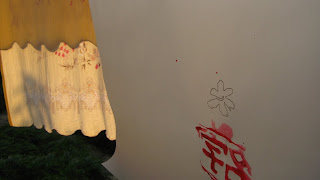 (My Paintings are Invisible, Davenport 2009)
(My Paintings are Invisible, Davenport 2009) Dec 17
Day 40
I try to show work in public spaces wherever possible, rather than hiding the poems away in obscure publications, or galleries. The pieces seem to gather energy and significance from being framed in everyday bustle. The idea of an exhibition outside of 501 has been at the back of my mind for awhile. I’ve come across two artists here whose text works I like and so I ask Wang Jun and Yao Bo if they’d be happy to be in a show curated by me. We talk the idea thru whilst sitting on the floor of Wang Jun’s studio, scribbling notes on paper scraps. We can’t decide on a title for the exhibition and dither around the possibles. I mention my old working title for the poems, and Yao Bo repeats it back, subtly corrupted: “Speak is Code?”
And so the exhibition has its title and I put together a press notice:
SPEAK IS CODE
Jiao Tong Teahouse 28 December 2009
Yao Bo, Philip Davenport, Wang Jun
Jiao Tong Teahouse is a mesh of conversations, meetings, deals made, gambling, gossip and over it all, parrots swing on their perches, aping the human noise. It is an intersection and into it the work of three artists is placed for Speak is Code. The works explore the space between us all, locate the holes in language and - as Davenport’s poem says – “The impasse between skin.”
Yao Bo, ceramicist and painter premieres a version of her continuing major work On Reading Beckett: a long text response to Beckett is handwritten in Chinese script onto manuscript paper. “I was murmur-reading Beckett, muttering to myself. The poem shot sunlight from faraway into my thoughts…” As counterpoint, a series of collapsed pots – like collapsed lungs – are placed onto each piece of paper. From some of the pots comes the sound of the piece being read aloud. Yao Bo’s work explores the delicate seams of identity – where we join and where we fall apart. “These pieces of pottery are like the organs of no-body. Some silent, some murmuring, some…”
My Paintings are Invisible by Philip Davenport is a poem sequence combining Chinese and Western alphabets. The work is dedicated to Hai Zi (1965-89) the Chinese poet. Alphabets of East and West entwine to make word pictures, ‘invisible paintings’, each given an imaginary colour. They are on translucent paper, scripted half in Chinese (by Chinese artists) and half in English. The two alphabets sometimes join, sometimes separate. These are ‘paintings’ of absence, images that never grow clear – and Hai Zi becomes a symbol for all who are missing, all that we cannot say.

(txt/work, Wang Jun 2009)
Wang Jun is an artist whose works balance meaning against nothing. His recent pieces cross-breed industrial processes with the landscapes of hanzi that fill his paintings. He crunches together the Tao Te Ching, Wittgenstein and postmodernity into mould-pressed misfits. He will install a bookshelf of unreadable materials in the teashop.
Exhibition curated by Philip Davenport, artist in residence 501 Artspace. Contributing artists to My Paintings are Invisible; Dan Ting, Deng Chuan, Mao Yan Yang, Pang Xuan, Wang Jun, Xu Guang Fu, Yan Yan, Zheng Li; translation Deng Chuan, Yan Yan and Zhong Na. Philip would like to thank all for their kindness and for the beauty of their writing.
“I am trying to achieve a pre-verbal state by stacking layer upon layer of language. It is an impossible task, but it is my life.” (Yao Bo)
Curated by Philip Davenport
Supported by 501 Artspace/Arts Council England










